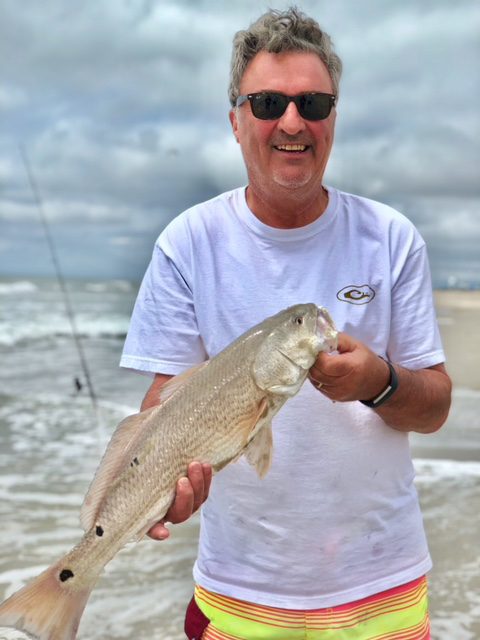Swansboro – June 7, 2018
Rich, of The Reel Outdoors, reports that inshore anglers are starting to find a good presence of flounder and red drum on all the typical baits, though cut mullet and topwater lures seem to be the best. The flounder can be found in the inlets, while the drum are up around the marshes.
Spanish, bluefish, sea mullet, and pompano are all in the suds, where Gotcha plugs and shrimp are the best choices for bait.
Kings are hanging on the Southeast Bottoms, but they can also be found a little closer in. These are 18-20 lb. fish that aren’t picky. Dead or live bait will work for them.
Matt, of Pogie’s Fishing Center, reports that redfish schools are practically all broken up, and anglers are going to start to see more fish showing up in mainland creeks and rivers as the days keep getting hotter. Topwater plugs on low-wind days are perfect for locating fish. Gulp shrimp in jerk shad and 1/8 oz. jig heads are also a great choice. As always, cut and live mullet on Carolina rigs that are cast to oyster rocks and marsh points will produce fish.
Summertime numbers of flounder are starting to show up regularly. Gulp baits fished on 1/4 oz. jig heads and bucktails around docks, bulkheads, and bridges offer the best bite for flatties. When fishing deep water or in a strong current, adjust the weight of your tackle as needed.
Black drum are being caught in deep holes both in the marsh and on the White Oak River. Cut shrimp on bottom rigs and small Carolina rigs are the best way to catch them. Anglers fishing for sheepshead around bridges will see some bigger black drum when using fiddler crabs.
The sheepshead bite is nearly in full swing. Anglers are connecting to smaller fish with a bunch of keepers mixed in on area bridges. You can’t go wrong with fiddler crabs on heavy Carolina or drop shot rigs.

Serenity Williams, of Denver, CO, with her first ever mahi. The fish fell for live bait 12 miles out of Bogue Inlet. Williams was fishing with Capt. Bobby Bourquin of Teezher Charters.
Dale, of Dudley’s Marina, reports that the red drum bite has slowed, but anglers are still finding them on cut mullet, Gulps, and topwater baits.
Sheepshead are starting to show up around docks and bridges, as are some flounder and black drum. Fiddler crabs are working best for the sheepshead.
Spanish and bluefish are biting off the beach, and kings are showing up between 7-8 miles. Cobia are still hanging out on nearshore ARs and haven’t moved away yet.
Dolphin are biting strong offshore, and while wahoo are being caught as well, the wahoo bite isn’t nearly as consistent.
Rob, of Sandbar Safari Charters, reports that red and black drum are feeding along oyster points in the shallows. Topwaters and plastics are working for the reds, while live and dead shrimp are more effective for the blacks. You can find flounder, bluefish, and sand sharks by drifting the inlet channels with live baits (especially tiger minnows).
Little has changed when it comes to the nearshore bite. Some scattered cobia are still around working bait balls along Emerald Isle, and there are plenty of blues and sharks working the bait as well.
Johnathan, of On Point Charters, reports that the rain hasn’t had too much of an effect on area fishing, as the runoff isn’t as bad as it is to the north and south. Red drum are being caught in the shallow bays behind the barrier islands and have been taking Fathom rat tails rigged weedless, topwaters, and both cut and live mullet.
Flounder have been hanging around the docks along the ICW and creek mouths (on the falling tide). They are also falling for Fathom rat tail baits on 1/4 oz. jig heads, in addition to live mullet on Carolina rigs.
Sheepshead and black drum are being caught around area bridges and docks. Both will bite fiddler crabs on Carolina rigs.
Spanish mackerel are present and can be caught by casting metal jigs or by trolling. Cobia are still coming into the area, where they can be found around bait balls. If the water is clear enough, sight fishing with bucktails is a great way to catch them just off the beach.

Gary Penny, President of the Durham Surf Club, with a slot puppy drum caught on cut mullet in the Atlantic Beach surf.
Bobby, of Teezher Charters, reports that nearshore fishing has been good thanks to a strong presence of spanish and king mackerel, cobia, and bluefish.
The kings are within 5 miles of the beach. Anchoring up around a buoy and jigging up live spanish sardines and cigar minnows will get the bait needed to throw out a live bait rig and start looking for fish.
Trolling spanish sardines could attract a cobia, too, and they can also be caught on any type of artificial or by blind casting live menhaden to the bait pods around the beach.
On the bottom, not much has changed. Sea bass and triggers are the most cooperative bottom feeders right now.
A good mix of both gaffer and slinger dolphins are being caught, in addition to a few tuna and wahoo. Sailfish and blue marlin are also biting offshore.
Amanda, of Bogue Inlet Pier, reports a strong catch of mullet, bluefish, and spanish mackerel. A few croakers and pompano have also come in here and there.
